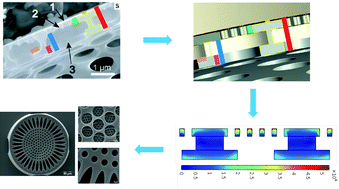The role of hierarchical design and morphology in the mechanical response of diatom-inspired structures via simulation
Abstract
Diatoms are microscopic algae with intricate shell morphologies and features ranging from the nanometer to the micrometer scale, which have been proposed as templates for drug delivery carriers, optical devices, and metamaterials design. Several studies have found that diatom shells show unique mechanical properties such as high specific strength and resilience. One hypothesis is that these properties stem from the structural arrangement of the material at the nanometer and micrometer length scales, challenging the concept between what constitutes a “material” versus a “structure”. In this work, we have conducted a systematic simulation-prototyping study to shed light on the mechanics of diatom-inspired hierarchical microstructures. The Finite Element Method (FEM) was used to replicate three-dimensional diatom shells under compressive forces. The intricate hierarchical shell structure of the Coscinodiscus sp. diatom frustule observed in nature was reproduced in detail. Simulation parameters were selected to reproduce compression experiments, with a force distributed on the surface of the diatom shell. A frustule diameter of 50 μm was used with pore diameters ranging from 0.25 to 1.2 μm across different layers. A “unit cell” FEM model was also created to focus on the basic structural element of a diatom frustule. Both of these models were used to elucidate the relation between morphology and mechanical response. Additionally, select designs were prototyped using 3D Direct Laser Writing (DLW) lithography to evaluate the feasibility of manufacturing diatom-inspired devices at the micro-scale. Distinct correlations between pore size in each frustule layer, or pore shape in the basal layers, and the mechanical response of the diatom shell were established in this study. The 3D-DLW prototypes exhibit a similar level of intricate morphological traits observed in real diatoms, opening the possibility of a simulation-based process for the design and fabrication of diatom-inspired microdevices. This research helps explain how morphology features are central to the mechanical performance of hierarchically arranged structures and biomaterials in general, and it represents a step toward the manufacture of emerging metamaterials and microarchitectures.



 Please wait while we load your content...
Please wait while we load your content...